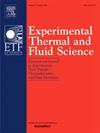量化气泡表面积与气体演化速率的关系
IF 2.8
2区 工程技术
Q2 ENGINEERING, MECHANICAL
Experimental Thermal and Fluid Science
Pub Date : 2025-01-11
DOI:10.1016/j.expthermflusci.2025.111412
引用次数: 0
摘要
冒泡是几乎所有工程领域的普遍现象。例如,在气/液分离中,流出液体的气体的传质速率受到系统冒泡的影响,最终影响到可用于传质的面积。本研究旨在了解气泡表面积对液体中气体演化(传质)行为的影响。传质过程中液体的鼓泡表现为低鼓泡、过渡鼓泡和高鼓泡三种状态。设计了一种光学技术,利用高清摄像机来确定气泡的直径。气泡表面积的增加与传质率的增加直接相关。此外,观察到液体粘度在起泡行为中起主要作用。在气体演化过程中,无论混合速度如何,粘度低于96 cP的流体都不会出现气泡。随着流体粘度的增加,鼓泡的容易程度增加。无论流体粘度如何,在气体吸收过程中均未见冒泡现象,说明冒泡现象是气体演化过程的结果。本文章由计算机程序翻译,如有差异,请以英文原文为准。
Quantifying the relationship between bubble surface area and gas evolution rate
Bubbling is a common phenomenon in nearly all fields of engineering. For example, in gas/liquid separations, the mass transfer rate of gas exiting the liquid is affected by the bubbling of the system, and ultimately the area available for mass transfer. This study is aimed at understanding the influence of bubble surface area on gas evolution (mass transfer) behavior in liquids. Bubbling was characterized by three regimes: low bubbling, transitional bubbling, and high bubbling in the liquid during the mass transfer process. An optical technique was designed to determine bubble diameters using an HD camera. Observations of an increase in bubble surface area were directly correlated to an increase in the mass transfer rate. In addition, liquid viscosity was observed to play a major role in the bubbling behavior. Fluids with viscosity lower than 96 cP did not experience bubbling irrespective of mixing speeds during the gas evolution process. With an increase in the fluid viscosity, the ease of bubbling increased. Bubbling was not seen during the gas absorption process irrespective of fluid viscosity, indicating the bubbling phenomenon is a result of the gas evolution process.
求助全文
通过发布文献求助,成功后即可免费获取论文全文。
去求助
来源期刊

Experimental Thermal and Fluid Science
工程技术-工程:机械
CiteScore
6.70
自引率
3.10%
发文量
159
审稿时长
34 days
期刊介绍:
Experimental Thermal and Fluid Science provides a forum for research emphasizing experimental work that enhances fundamental understanding of heat transfer, thermodynamics, and fluid mechanics. In addition to the principal areas of research, the journal covers research results in related fields, including combined heat and mass transfer, flows with phase transition, micro- and nano-scale systems, multiphase flow, combustion, radiative transfer, porous media, cryogenics, turbulence, and novel experimental techniques.
 求助内容:
求助内容: 应助结果提醒方式:
应助结果提醒方式:


